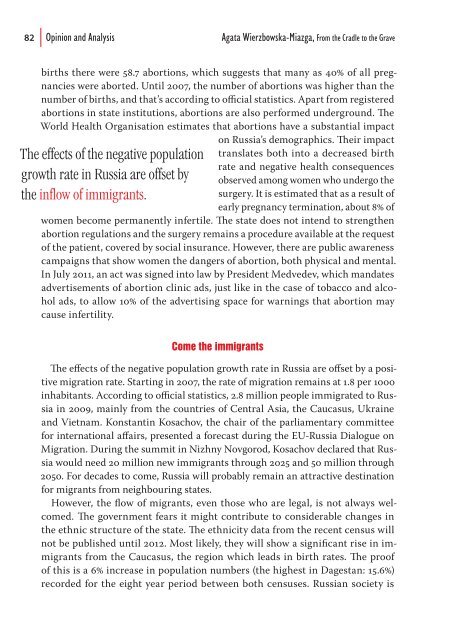Create successful ePaper yourself
Turn your PDF publications into a flip-book with our unique Google optimized e-Paper software.
82<br />
Opinion and Analysis Agata Wierzbowska-Miazga, From the Cradle to the Grave<br />
births there were 58.7 abortions, which suggests that many as 40% of all pregnancies<br />
were aborted. Until 2007, the number of abortions was higher than the<br />
number of births, and that’s according to offi cial statistics. Apart from registered<br />
abortions in state institutions, abortions are also performed underground. Th e<br />
World Health Organisation estimates that abortions have a substantial impact<br />
on Russia’s demographics. Th eir impact<br />
The effects of the negative population<br />
growth rate in Russia are offset by<br />
the inflow of immigrants.<br />
translates both into a decreased birth<br />
rate and negative health consequences<br />
observed among women who undergo the<br />
surgery. It is estimated that as a result of<br />
early pregnancy termination, about 8% of<br />
women become permanently infertile. Th e state does not intend to strengthen<br />
abortion regulations and the surgery remains a procedure available at the request<br />
of the patient, covered by social insurance. However, there are public awareness<br />
campaigns that show women the dangers of abortion, both physical and mental.<br />
In July 2011, an act was signed into law by President Medvedev, which mandates<br />
advertisements of abortion clinic ads, just like in the case of tobacco and alcohol<br />
ads, to allow 10% of the advertising space for warnings that abortion may<br />
cause infertility.<br />
Come the immigrants<br />
Th e eff ects of the negative population growth rate in Russia are off set by a positive<br />
migration rate. Starting in 2007, the rate of migration remains at 1.8 per 1000<br />
inhabitants. According to offi cial statistics, 2.8 million people immigrated to Russia<br />
in 2009, mainly from the countries of Central Asia, the Caucasus, Ukraine<br />
and Vietnam. Konstantin Kosachov, the chair of the parliamentary committee<br />
for international aff airs, presented a forecast during the EU-Russia Dialogue on<br />
Migration. During the summit in Nizhny Novgorod, Kosachov declared that Russia<br />
would need 20 million new immigrants through 2025 and 50 million through<br />
2050. For decades to come, Russia will probably remain an attractive destination<br />
for migrants from neighbouring states.<br />
However, the fl ow of migrants, even those who are legal, is not always welcomed.<br />
Th e government fears it might contribute to considerable changes in<br />
the ethnic structure of the state. Th e ethnicity data from the recent census will<br />
not be published until 2012. Most likely, they will show a signifi cant rise in immigrants<br />
from the Caucasus, the region which leads in birth rates. Th e proof<br />
of this is a 6% increase in population numbers (the highest in Dagestan: 15.6%)<br />
recorded for the eight year period between both censuses. Russian society is



